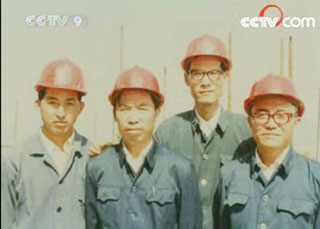------Program code: DO-080613-01581 (what's this?)
Source: CCTV.com
06-13-2008 08:51
Shennan Boulevard offers pleasant views of the city of Shenzhen in South China. One building looks rather dilapidated compared to the others around it. But in the 1980s, it was synonymous with “Shenzhen Speed”, which was known all over China.
 |
The photograph was taken twenty years ago. Colour photographs were very rare at the time. This particular one was printed in many newspapers. The four men in red safety helmets were called the “Four Red Hats Who Created Shenzhen Speed”.
 |
The headquarters of the No. 3 Bureau of the China Construction Corporation are located in the city of Jingmen in Hubei Province. The four men wearing the red safety helmets in the photograph once worked for the bureau. Two of them were senior executives: Bureau Chief Zhang Enpie and Deputy Bureau Chief Li Chuanfang. Like most state-owned enterprises in those years, the No. 3 Bureau faced a constant struggle for financial survival.
And it was difficult for us to make money. To cope with all these problems, Zhang Enpei was forced to beg for contracts to carry out construction projects. So difficult was the situation that, when the Chinese government decided to set up the “Special Economic Zones” in South China, Zhang Enpai boarded a train for the south, without even waiting for permission from his bosses.
The Shenzhen River is a small tributary of the Pearl River. It is only 37 kilometers long from its source to the point where it joins the Pearl River. On one side is Asia’s leading financial centre, Hong Kong, and on the other is Bao’an County in Guangdong Province. At that time, anyone traveling to Shenzhen first had to obtain permission from their work unit, as well as a special pass to visit the frontier issued by the public security bureau.
In May 1980, the State Council issued the “Review of the Meeting Concerning the Two Provinces of Guangdong and Fujian”. The document declared that “Special Economic Zones” would be set up on a trial basis in the three cities of Shenzhen, Zhuhai and Shantou in Guangdong Province and in the city of Xiamen in Fujian Province.
This heralded an upsurge in urban construction in South China. Zhang Enpai decided to bring his workers to Shenzhen. Among the advance group were two young men, Luo Jundong, a recent university graduate, and Wang Yugang who would be in charge of the International Trade Centre Project. What greeted them when they arrived in Shenzhen was a sight they had never seen before.
